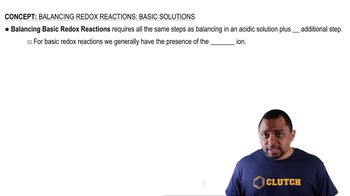Here are the essential concepts you must grasp in order to answer the question correctly.
Oxidation and Reduction
Oxidation and reduction are chemical processes that involve the transfer of electrons between substances. Oxidation refers to the loss of electrons, resulting in an increase in oxidation state, while reduction involves the gain of electrons, leading to a decrease in oxidation state. In redox reactions, one species is oxidized and another is reduced, making it essential to identify these changes to balance the equations correctly.
Recommended video:
Oxidation and Reduction Reactions
Balancing Redox Reactions
Balancing redox reactions requires ensuring that both mass and charge are conserved. This often involves separating the reaction into half-reactions for oxidation and reduction, balancing each half for atoms and charge, and then combining them. In acidic or basic solutions, additional steps may include adding H+ ions or OH- ions to balance hydrogen and oxygen atoms, respectively.
Recommended video:
Balancing Basic Redox Reactions
Identifying Oxidizing and Reducing Agents
In a redox reaction, the oxidizing agent is the substance that gains electrons and is reduced, while the reducing agent is the substance that loses electrons and is oxidized. Identifying these agents is crucial for understanding the reaction's dynamics and predicting the products. This can be determined by analyzing the changes in oxidation states of the elements involved in the reaction.
Recommended video:
Oxidizing and Reducing Agents





